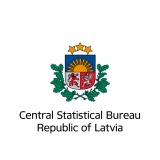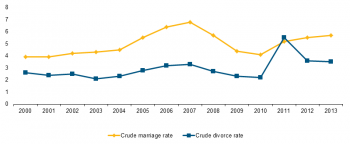Archive:Marriages and births in Latvia
Marriage and fertility rates keep improving in Latvia
- Author: Elmīra Seņkāne, Central Statistical Bureau of Latvia
- Data extracted in June 2015.
This article on marriages and births is part of a pilot project implemented by Eurostat together with the Member States. The aim of the pilot project is to better reply to user's needs by complementing the Eurostat article presenting data on an EU level with more detailed information on the same topic, but at national level. Articles from the participating Member States are available in the corresponding national languages as well as in English and they form, together with the Eurostat article, an online publication.
This article presents the key statistical indicators on marriages and the number of births in Latvia during the time period from 2000 - 2013. Over the past decade the size of the Latvian population and its structure has changed significantly, which has had a negative impact also on marriage and fertility rates. Only during the last three to four years have demographic indicators been improving, which is related to the fact that the generation which was born in the middle of the eighties has reached the typical age for marriage and childbearing. The highest fertility rates during the last 50 years were registered in 1986 - 1988. In 2013 the number of marriages per 1 000 population as compared with 2000 had increased 1.6 times, and the fertility rate 1.3 times.
Main statistical findings
27 % of population aged over 20 are single
According to the results of the Population and Housing Census 2011, 777.4 thousand or 37.6 % of the Latvian population were married, 859.9 thousand or 41.5 % were single[1], 247.9 thousand or 12.0 % were divorced, and 185.2 thousand or 8.9% widowed.
In the age group over 20, 46.9 % of the population were married, 26.9 % single, 15.0 % were divorced and 11.2 % were widowed. The age at first marriage has been increasing each year. According to the 2011 census, among married persons 6 % of males and 9 % of females were aged 20-29 which is 2 percentage points less than in the 2000 census (8 % and 11 %, respectively).
The share of married people in 2012, as compared with 2011, has slightly decreased: in the age group over 20 years, 46.3 % of the population were married.
Almost 10 % of the Latvian population over 20 years of age live in a consensual union without legal basis
According to the 2011 census results, 152 thousand people or 9.2 % of the population aged over 20 who lived in the same household were cohabiting partners, whose relationship was not officially registered.
Number of marriages and age at first marriage keep growing
In 2013, 11 436 marriages were registered in Latvia, which was 1.7 % more than in 2012, and 35.9 % more than in 2000. In 2013, the crude marriage rate or the number of marriages concluded per 1 000 population was 5.7 (in 2012 it was 5.5 marriages).
In 2007, the largest number of marriages during the last 14 years was registered: 15 486 marriages, and the crude marriage rate was 7.0. In contrast, the smallest number of marriages was recorded in 2000 – 9 211 marriages, and the crude marriage rate dropped to 3.9.
In recent years, the age at first marriage has increased significantly. In 2002 the age at first marriage was 27 years for men and 25 years for women, while in 2013 men registered their first marriage at the age of 31 and women at the age of 28.
Number of divorces is relatively high in Latvia
7 031 marriages were dissolved in Latvia in 2013, and the crude divorce rate or the number of divorces per 1 000 population was 3.5. There were on average 60 divorces per 100 registered marriages. Compared with 2012, the number of dissolved marriages decreased by 3.8 %.
The lowest number of divorces was registered in 2003 - 4 828 divorces, and the crude divorce rate was 2.1. The number of divorces reached its peak in 2011. On 1 February 2011 amendments to the Latvian legislation took effect entitling sworn notaries the right to dissolve marriages. It made the divorce process easier and faster, and in 2011 the number of divorces increased significantly (by 68.4 % as compared with 2010).
Since 2000, the share of dissolved marriages which had lasted for 20 and more years has increased significantly - from 16 % of divorces in 2000 to 28 % and 30 % in 2011 and 2012 respectively.
Number of births and mean age of mother at childbearing have been increasing
Over the past three years, fertility has been improving in Latvia, with 20.6 thousand children born in 2013. The crude birth rate was 10.2, compared with 8.6 live births in 2000. The highest birth rates were registered in 1986 - 1987, when the number of births was twice as large - an average of 42 thousand babies a year.
The mean age of mothers at childbearing in 2013 was 29.6 years, while at the birth of the first child it was 26.1 years. In contrast, in 2000 the mean age of mothers at childbearing was 27.3 years, while at the birth of the first child it was 24 years. One of the reasons for the increase in the birth rate is that women who were born in the middle of the eighties, when the birth rate was highest, have reached their childbearing age. At the beginning of 2014, out of all women of childbearing age (15-49 years) 30 % were 25-34 years old (at the beginning of 2000 it was 27 %).
An indicator characterising generation replacement is the total fertility rate (the number of live births per woman). In Latvia this indicator grew to 1.52 in 2013 (in 2000 it was 1.25); however, it still lags behind the replacement level of 2.1-2.2. The last time a total fertility rate of 2.2 was registered was in 1986 - 1987.
The fertility rate among younger women has been decreasing. In the eighties the highest fertility rate was registered among women aged 20-24: 150-170 live births per 1 000 women. In 2000, the fertility rate among 1 000 women of this age group was two times lower, at 79 live births, and in 2013 only 56 live births per 1 000 women. The fertility rate among women aged 25-29 has increased from 80 live births per 1 000 women in 2000 to 95 live births in 2013. Since 2000, in the age group 30 - 44 the number of live births per 1 000 women has increased two times on average.
In recent years, the number of second and third children in the total number of births has been growing in Latvia; for example, the share of second children out of the total number of births rose from 32 % in 2000 to 37 % in 2013. In 2000, out of all children born to women aged 20-34, 35 % were second children: in 2013 it was 38 %.
In 2013, 55 % of children were born to parents who were officially married. In 2000 this figure was 60 %, while in the eighties the share of children born in registered marriage was close to 90 %. Increasingly more often marriage is concluded when there already is one or several children in the family. In 2000 the age of women at first marriage was 0.9 years higher than the age of women at birth of first child, but in 2013 the gap had already reached 2.2 years.
See also
External links
- CSB of Latvia publications
Notes
- ↑ Persons who were never married or in a registered partnership







